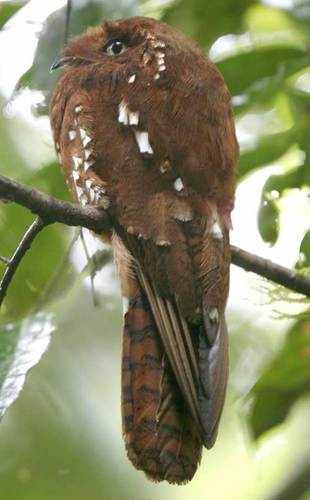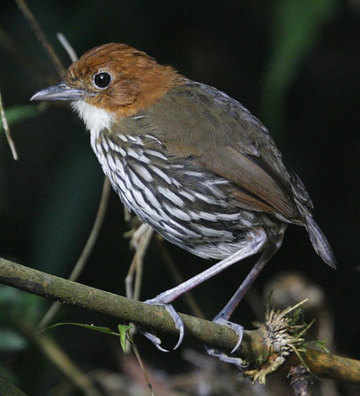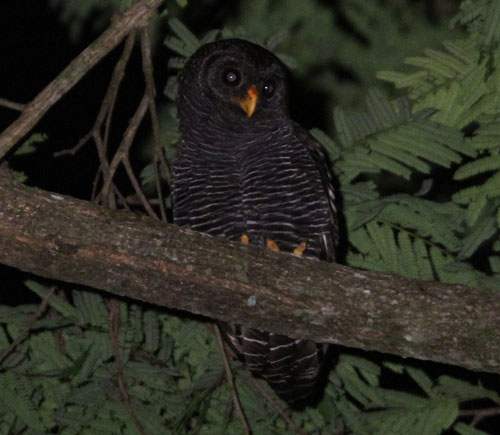Ecuador - The Amazon
Thursday 5th October - Saturday 14th October 2017 (Main Tour)
Monday 2nd October - Thursday 5th October 2017 (Antpitta Pre-tour Extension)
 This unique shorter tour is aimed at experiencing the vast range of awesome birds residing in the Amazonian lowlands of eastern Ecuador from two of the most secluded lodges currently available. We have to fly over the Andes and then drive a couple of hours before taking a motorized canoe for a thrilling 4 hour journey along the Shiripuno River to an incredibly secluded lodge that has been seldom visited by birders. With an excellent network of trails taking us deep into the Yasuni Biosphere Reserve that is the ancestral home to the indiginous Waorani People, we will see an incredible array of amazing birds. Here we will look for star birds such as Salvin's Curassow, Rufous Potoo, Fiery Topaz, White-plumed Antbird and many, many others. Moving on to Sani Lodge via a two and a half hour boat ride along the Napo River, this comfortable lodge is owned by the indigenous Kichwa community and is located beside a secluded oxbow lake in the heart of the Amazon rainforest and has earned a reputation as one of the finest places for birding in the whole of Amazonia. Nearly 600 species of birds are known from this single locality, including five species of macaw, 10 puffbirds, seven toucans and more than 40 species of antbirds! This is an amazing place to get an insight into the vast array of birdlife present by visiting the canopy tower which affords eye-level views of species such as Lemon-throated Barbet, Golden-collared Toucanet, Purple-throated Cotinga and a wide variety of other species. The oxbow lake has the bizarre Hoatzin and Zigzag Heron, there are parrot-licks with Mealy and Yellow-crowned Amazons, Blue-headed and Orange-cheeked parrots visiting for their daily mineral fix, and a great network of trails. This is going to be an action-packed tour where we will get to see some of the rarest and localised species on the planet and in the company of our excellent local guide, Juan Carlos Calvachi.
This unique shorter tour is aimed at experiencing the vast range of awesome birds residing in the Amazonian lowlands of eastern Ecuador from two of the most secluded lodges currently available. We have to fly over the Andes and then drive a couple of hours before taking a motorized canoe for a thrilling 4 hour journey along the Shiripuno River to an incredibly secluded lodge that has been seldom visited by birders. With an excellent network of trails taking us deep into the Yasuni Biosphere Reserve that is the ancestral home to the indiginous Waorani People, we will see an incredible array of amazing birds. Here we will look for star birds such as Salvin's Curassow, Rufous Potoo, Fiery Topaz, White-plumed Antbird and many, many others. Moving on to Sani Lodge via a two and a half hour boat ride along the Napo River, this comfortable lodge is owned by the indigenous Kichwa community and is located beside a secluded oxbow lake in the heart of the Amazon rainforest and has earned a reputation as one of the finest places for birding in the whole of Amazonia. Nearly 600 species of birds are known from this single locality, including five species of macaw, 10 puffbirds, seven toucans and more than 40 species of antbirds! This is an amazing place to get an insight into the vast array of birdlife present by visiting the canopy tower which affords eye-level views of species such as Lemon-throated Barbet, Golden-collared Toucanet, Purple-throated Cotinga and a wide variety of other species. The oxbow lake has the bizarre Hoatzin and Zigzag Heron, there are parrot-licks with Mealy and Yellow-crowned Amazons, Blue-headed and Orange-cheeked parrots visiting for their daily mineral fix, and a great network of trails. This is going to be an action-packed tour where we will get to see some of the rarest and localised species on the planet and in the company of our excellent local guide, Juan Carlos Calvachi.
Targets:
|
|
PRE-TOUR ANTPITTA EXTENSION: 2ND OCTOBER - 5TH OCTOBER
 |
 |
 |
 |
 |
 |
 |
 |
 |
 |
 |
 |
 |
 |
 |
 |
 |
 |
 |
 |
 |
 |
 |
 |
 |
Pre-tour Day 1 Arrive Quito, Ecuador - 2nd October
Today is the arrival day in Quito where you will be met and transferred to our comfortable accommodation. Night in Quito
Our focus this morning will be to experience the spectacle of seeing several species of antpitta being fed worms by a local farmer at the now famous Angel Paz Reserve. By putting out worms he has attracted several seldom-seen forest dwellers, namely Giant, Yellow-breasted, Moustached and rarely Ochre-breasted Antpitta, as well as Dark-backed Wood-Quail. Few people have ever seen such difficult birds up close and just a few feet away! Bring your camera! There should be plenty of other species to keep us busy and in particular we will look for Orange-breasted Fruiteater and Olivaceous Piha.
For the rest of the day we will bird our way along the road or visit some trails in the cloud forest for 3 Choco endemics - Toucan Barbet, Plate-billed Mountain Toucan and the elusive Tanager Finch. Others species in the area should include Beautiful Jay, Masked Trogon, Ocellated Tapaculo, and a multitude of dazzling hummingbirds with names like Gorgeted Sunangel, Purple-bibbed Whitetip, Empress Brilliant and Long-tailed Sylph. Our first feeding flocks of tanagers could include Blue-winged Mountain-Tanager, Golden-naped, Fawn-breasted, Metallic Green, Flame-faced, Silver-throated, Orange-eared, Blue-capped and the wonderful Grass Green, whilst a supporting cast should find us Barred Hawk, both Powerful and Crimson-mantled Woodpeckers, Golden-headed Quetzal, Azara’s and Red-faced Spinetails, Uniform Treehunter, Spillman’s and Narino Tapaculos, Green-and-black Fruiteater, Tri-coloured Brush-Finch, Golden-bellied Grosbeak, Turquoise Jay, Masked and White-sided Flowerpiercers, Andean Solitaire, Black-crested and Three-striped Warblers, Long-tailed Antbird, White-tailed and Rufous-winged Tyrannulets, Olivaceous Piha and Plushcap. Returning for lunch-time we have great opportunities to study or photograph up close many of the areas fabulous hummingbirds. The tiny Racket-tailed Puffleg (formerly called Booted Racket-Tail) is always a favourite while others include Collared Inca, Buff-tailed Coronet, Green and Sparkling Violetear, the tiny Purple-throated Woodstar, Violet-tailed Sylph, Fawn-breasted Brilliant and Speckled Hummingbird. Several other species that are within easy reach of the lodge may include White-tailed Hillstar, Brown Inca, White-bellied Woodstar, Green-fronted Lancebill, Western and Andean Emeralds, Tawny-bellied Hermit, Green-tailed Trainbearer and Wedge-billed Hummingbird. Hopefully the resident Chestnut-crowned Antpitta will make its presence known by walking up a path towards us.
Other areas we will be visiting include the Mindo Valley and its lush cloud forests where there are lots of exciting birds to look for including Crimson-rumped Toucanet, Scaled Fruiteater, Club-winged Manakin, Wattled Guan and Red-billed Parrot. Down beside the fast running rivers White-capped Dipper and Black Phoebe will be sought, while new hummingbirds will include species such as Velvet Purple Coronet, Violet-tailed Sylph, White-whiskered Hermit, Green and Sparkling Violetear, Stripe-throated Hermit, Green Thorntail and Blue-chested Hummingbird. Amongst the hoards of colourful tanagers we can see are Glistening Green, Rufous-throated, Golden, Beryl-spangled, Grey-and-gold, Scarlet-browed and Black-capped, while amongst the bromeliads and moss encrusted branches we may find other species such as Streaked Tuftedcheek, Pearled Treerunner and Montane Woodcreeper. Our local guide knows where to find the specialities and a whole host of other sought-after species including Chestnut-mandibled Toucan, Pale-mandibled Aracari, Guayaquil Woodpecker, Pacific Hornero and Yellow-collared Chlorophonia. Taking in several other habitats we can add to our tanager list with Flame-rumped, White-capped, Tawny-crested, Scarlet-browed, White-shouldered and Swallow Tanagers, as well as Slate-coloured Grosbeak, Red-headed Barbet, Ornate and Rusty-margined Flycatchers, Streak-headed Woodcreeper, Pacific Antwren, Cinnamon and One-coloured Becards and a host of other goodies. Night at Septimo Paraiso.
Main Tour Day 1 Arrival in Quito, Ecuador - 5th October
This is purely an arrival day for the Amazonia tour, and upon arrival you will be met at Quito Airport and transferred to our comfortable accommodation for the night. Night in Quito.
Main Tour Day 2 Fly Quito - Coca - Shiripuno Lodge
We take a short flight over the Andes and down into the vast Amazonian wilderness to the small town of Coca. From here we will meet up with our vehicles and then drive 90kms south to the Shiripuno River where we will board a large motorized canoe that will take us 65kms and around 4 hours to the remote Shiripuno Lodge, where we will spend the next four nights. The boat ride will give us a great introduction to the more obvious Amazonian birds and our journey could provide us with species such as Cocoi Heron, Yellow-headed Caracara, Greater Yellow-headed Vulture, Collared and Pied Plovers, Large-billed and Yellow-billed Terns, Sand-coloured Nighthawk, Amazon and Ringed Kingfishers, Blue-and-yellow Macaw, Scarlet Macaw, White-throated Toucan, Swallow-wing, Chestnut-eared Aracari, Drab Water-Tyrant, Grey-capped Flycatcher,Bare-necked Fruitcrow, Violaceous Jay, Grey-breasted Martin, White-banded Swallow, Orange-backed Troupial, Magpie Tanager, Giant Cowbird and so much more.
Upon arrival at the remote Shiripuno Lodge we are going to find ourselves in a true wilderness. This is the gateway to Yasuni Biosphere Reserve and is set amidst pristine tropical Amazonian rainforest. The reserve area covers 16,820 square kilometres, surrounded by a 7,000 kilometre square Buffer Zone and a 4,820 Transition Zone. So after settling into our rooms we will begin our exploration of this awesome habitat. Night at Shiripuno Lodge.
There are several really stunning birds that we shall make it our priority to find during our time here, with the incredible Fiery Topaz being high on our wish-list, along with Rufous Potoo that will hopefully be seen at a day roost, and last but definitely not least we hope to encounter Salvin's Curassow - a species that is rarely seen anywhere but this is THE place to spot one. And other uncommon birds we could find include Crested and Harpy Eagle, Red-shouldered and Dusky-billed Parrotlets, Rufous-headed Woodpecker, Collared and Chestnut-capped Puffbirds, Pavonine Quetzal, Yasuni and Rio Suno Antwrens, and the shy Black-necked Red Cotinga.
Meanwhile, large mixed-species feeding flocks hold such delights as Wing-barred Piprites, Pink-throated Becard, Chestnut-winged Hookbill, Chestnut-winged Foliage-gleaner, Wedge-billed, Cinnamon-throated and Lineated Woodcreepers, Buff-throated Woodcreeper, Dugand’s Antwren, Dusky-capped Greenlet, Purple Honeycreeper, Black-faced Dacnis, Rufous-bellied Euphonia, Opal-crowned, Opal-rumped, Masked Crimson, Flame-crested and Fulvous-crested Tanagers.
There are numerous other species present here and we also hope to see Rufescent Tiger-Heron, Boat-billed Heron, White Hawk, Black and Red-throated Caracaras, Bat Falcon, Speckled Chachalaca, Cobalt-winged Parakeet, Black-headed Parrot, Orange-winged Amazon, Greater Ani, Tropical and Tawny-bellied Screech-Owls, Crested, Spectacled and Black-banded Owls, Common, Long-tailed and Great Potoos, White-bearded and Great-billed Hermits, Fork-tailed Woodnymph, Grey-breasted Sabrewing, Short-tailed Swift, Neotropical Palm-Swift, Black-tailed, Amazonian White-tailed, Collared, Black-throated and Amazonian Violaceous Trogons, White-eared, Yellow-billed and Brown Jacamars, Amazonian Motmot, Black-fronted, White-fronted and Yellow-billed Nunbirds, Gilded and Lemon-throated Barbets, Golden-collared Toucanet, Many-banded and Ivory-billed Aracaris, Channel-billed Toucan, Crimson-crested, Chestnut, Cream-coloured and Red-stained Woodpeckers, Long-billed, Amazonian Barred and Black-banded Woodcreepers, Orange-fronted Plushcrown, White-lored Tyrannulet, White-eyed Tody-Tyrant, Amazonian Scrub-Flycatcher, Brownish Twistwing, Blue-crowned Manakin, Spangled, Plum-throated and Purple-throated Cotingas, Purple-throated Fruitcrow, White-winged Swallow, Lawrence’s Thrush, Green Honeycreeper, White-lored Euphonia, Red-capped Cardinal, Oriole Blackbird, Casqued Oropendola and Solitary Cacique.
Other animals present here include Red Howler Monkey, Common Squirrel Monkey and Golden-mantled Tamarin. Nights at Shiripuno Lodge.
Day 6 Shiripuno Lodge - Sani LodgeNo doubt we will quickly get to see the bizarre and prehistoric-looking Hoatzins as we paddle quietly along the edge of the lake. Around the lakesides dense tangled vegetation, which gives us an insight into the permanently flooded forest, we will look for species such as Ringed, Amazon, Green and the scarcer American Pygmy and Green-and-rufous Kingfishers, White-chinned Jacamar, Rufous-breasted Hermit, Dot-backed, Plumbeous and Silvered Antbirds, Cinnamon Attila, Black-capped Donacobious, Buff-breasted Wren and Masked Crimson Tanager. One of our main goals will be to find the elusive and near-mythical Zigzag Heron, a regular nocturnal denizen of thick vegetation along Amazonian lakeshores. The boardwalk between the Napo River and the oxbow lake traverses excellent semi-flooded forest, and we’ll look for the Cream-coloured Woodpecker, Plumbeous and White-shouldered Antbirds and maybe even Cocha Antshrike.
At dusk we can hear Common Pauraque and Ferruginous Pygmy-Owls calling from the surrounding area. Night at Sani Lodge.
Days 7 - 8 Sani Lodge
What a place to wake up to with a cacophony of sounds emanating from the surrounding rainforest! One of the many highlights here are the parrot clay licks where hundreds of parrots come early in the morning to replenish their mineral supply by licking at exposed rocky areas. it is possible to see Mealy and Yellow-crowned Amazons, Blue-headed and Orange-cheeked Parrots and Dusky-headed Parakeet are all possible and provide an unforgettable spectacle.
Another great feature here is the 150-foot high canopy tower that provides a unique insight into canopy life of the tropical rainforest and has the advantage of giving eye-level views of birds we'd otherwise be looking at high overhead. It has a sturdy staircase and a sturdy wooden platform that wraps around a huge tree, where we hope to see species such as Slate-coloured Hawk, Blue-throated Piping-Guan, Cobalt-winged Parakeet, Lemon-throated Barbet, Lettered and Many-banded Aracaris, Golden-collared Toucanet, Spangled, Plum-throated and Purple-throated Cotingas, Yellow-browed Tody-Flycatcher, Eastern Sirystes, White-browed Purpletuft, Black-capped Becard, Fulvous Shrike-Tanager, White-browed Purpletuft, Green-and-gold, Opal-rumped, Paradise,Turquoise and Yellow-bellied Tanagers amongst others.
But we will probably need to spend more time on the network of trails that take us through superb primary varzea rainforest and, as always, we will be hoping for an army ant swarm. The list of species found in this vanishing habitat is seemingly limitless and our patience and stealth could be rewarded with such prizes as Great and Cinereous Tinamous, Purplish and even Yellow-billed Jacamar, Short-billed Leaftosser, Ringed Antpipit, Scale-breasted, Ringed and Rufous-headed Woodpeckers, Collared Puffbird, Ochre-striped Antpitta, Fulvous Antshrike, Lunulated, Hairy-crested, White-plumed and Banded Antbirds, Blue-crowned, Golden-headed and Wire-tailed Manakins, the rare Orange-crested Manakin, Chestnut-belted Gnateater, Screaming Piha and Rusty-belted Tapaculo. And there is always a chance of finding the rare Cocha Antshrike
There are many possibilities for our night-time forays as this amazing area holds Great, Common and Long-tailed Potoos, Tawny-bellied and Tropical Screech-Owls, Black-banded, Crested and Spectacled Owls and Short-tailed Nighthawk. Nights at Sani Lodge.
Day 9 Sani Lodge - Coca - Quito
We will have a final morning in this fantastic area to either revisit the canopy tower, take a boat ride around the oxbow lake or look for some rare birds on one of the islands in the Napo River. This latter option would give us the chance to see some truly localised species such as Olive-spotted Hummingbird, Lesser Hornero, White-bellied Spinetail, Lesser Wagtail-Tyrant, Castelnau’s Antshrike, Black-and-white Antbird, and even Scarlet-crowned Barbet or Orange-headed Tanager. But all too soon it will be time to leave and we will return to Coca by motorized canoe and take a flight back to Quito. Upon arrival we will transfer to our guides' lodge in Quito for our last night.
Leader: Nick Bray & Juan Carlos Calvachi
Group size: Minimum for tour to go ahead 6 and maximum 10.
Included in cost: Accommodation in twin rooms, all meals, ground transport throughout, domestic airfare (Quito - Coca return), boat rides, entrance fees, bottled water, snacks and services of leaders.
Not included: International flight, insurance, drinks, tips, and items of a personal nature.
Accommodation: We will be staying in two very good lodges that are ideally located within the Amazon rainforest. Please see www.sanilodge.com and www.shiripunolodge.com to see just how good they are.
Tour Code: This is a standard birding tour with all day birding, include early starts and some late finishes when owling. It is usually warm and humid and we do expect the odd shower in the Amazon lowlands, which is far better than sunshine for birding here! Most days we will return to the lodge for lunch, although we can also take a packed lunch if we decide to visit some of the more far-flung trails.
Receive our e-newsletter:
Join the Zoothera e-mailing list for up-to-date news on new tours, tour reports and special offers.
e-mail [email protected] to sign up
Recommended Books, CD's and more from NHBS. Click on link - to go straight to NHBS website!
The air holidays and flights shown are ATOL protected by the Civil Aviation Authority.
Our ATOL number is 10436. Please see our Terms and Conditions for more information.
